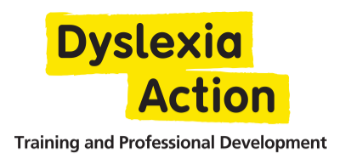How to Become a Specialist Teacher or Practitioner for Literacy-Related Difficulties
Lucy Howes

Working in the field of dyslexia (and other literacy difficulties) is incredibly rewarding. You will have the potential to make a meaningful difference in the lives of young people or adults, helping dyslexic students learn to read, as well as develop vital life skills.
To become qualified to provide one-to-one or group tuition for dyslexic primary, secondary or adult learners, you will need to gain a literacy-focused Level 5 or Level 7 qualification in Specific Learning Difficulties (SpLD). This will allow you to practice as a Specialist Teacher/Practitioner for Literacy-Related Difficulties – also referred to as a Dyslexia Teacher/Practitioner.
Dyslexia Action Training is one of the most well-known accredited providers of these qualifications. We train hundreds of education specialists each year and offer expert tuition and guidance as you create your individual literacy plans for individual learners as part of our teaching programmes.
Do I need to hold QTS to become a specialist teacher?
It might come as a surprise to learn that you don’t necessarily need to hold QTS or PGCE in order to become qualified – you just can’t refer to yourself as an SpLD Teacher or Specialist Teacher, the correct title would be “Practitioner.” We support many teaching assistants who want to become qualified in this way.
What does the training involve?
Each of our three training routes is slightly different, but delegates on all programmes will be trained to use the The Dyslexia Action Literacy Programme – DALP.
DALP is both a training programme and structured, cumulative multisensory literacy intervention, based on evidence-backed methods including the Orton Gillingham approach. It is designed to structure language-learning contexts to maximise the progress that learners with literacy-related learning difficulties can achieve.
The programme guides teachers through a pre-intervention assessment process in order to create a personalised literacy profile for each dyslexic learner. It then allows you to tailor the intervention to systematically address strengths and weaknesses through fun, interactive activities that can be adapted across any age group.
Which training route is right for me?
We offer a fast-track 12-month route for graduates at Level 5 or Level 7 and a 24-month learning route at Level 5 if you don’t have a degree or QTS/PGCE. You will need recent and relevant experience in a suitable setting for either pathway. Please note that there are other entry criteria.
Choosing the best study route will depend on a number of factors, including;
- how quickly you want to qualify
- whether you hold QTS, PGCE or a degree
- and the amount of recent and relevant experience that you have
- whether you want to go on to become a dyslexia assessor
Find out more by watching our video below:
Learn more about the training routes:
- Level 5 Diploma in Specialist Teaching graduate fast-track route
- Level 5 Diploma in Specialist Teaching – CPD route for those without QTS/degree
- Level 7 Postgraduate Certificate in Specialist Teaching for Literacy Related Difficulties
- Level 7 Postgraduate Diploma in Specialist Assessment and Teaching for Literacy Related Difficulties



